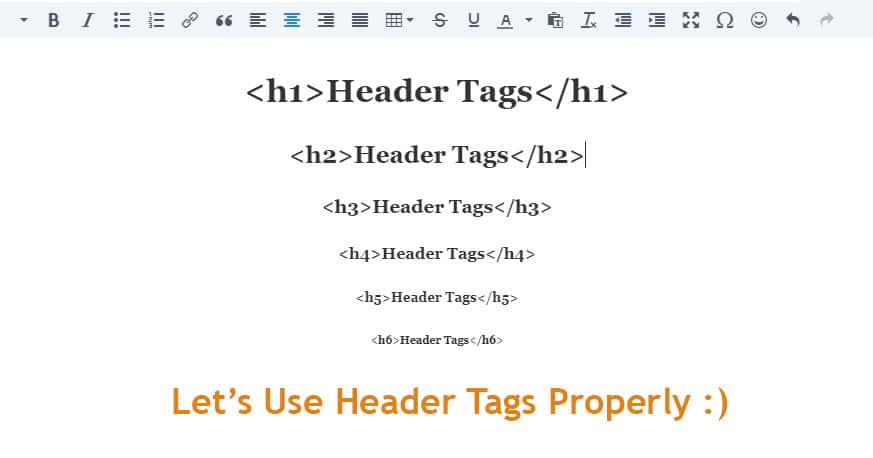What Are Headings? Why Use Them
A heading is the larger-sized text on a webpage. For example, on this page the main header is “On Page SEO Basics: Header Tags”. There can be many headings on a page. We’ll talk about the whats and whys of headers in this article.
Headings Help Create Visual and Contextual Structure
Webpages that have a lot of text can be very challenging to read if the text goes on and on and on. Headers can be used to break text up into more manageable blocks to read. People tend to scan webpages so headers help people understand where you’re introducing a new topic.
Use Headers to Create Hierarchy
There is a hierarchy of header tags, starting at <h1> and going down in size to <h6>. Ideally a page should only have a single <h1> tag. This is the largest header and should be used to indicate the main title or topic of the page. If your webpage is a book, your <h1> tag is the front cover title.
<h2> header tags are akin to book chapters. Use them to indicate important sections. Your <h3> and smaller tags are used to indicate subsections. If you consider a webpage with a long-ish article, the header structure might ideally look something like this:
- <h1> Article Title
- <h2> Major Subheader
- <h3> Subheader
- <h3> Subheader
- <h2> Major Subheader #2
- <h3> Subheader
- <h3> Subheader
- <h2> Major Subheader
Use Headers to Enhance SEO
Search engines like information that is structured. Using headers to structure your content is why they help with SEO. In the old days of search engine optimization, people used to cram as many keywords as possible into header tags because search engines tended to give header text more authority. Those days are long gone.
Using keywords in headers is fine but you can overdo it. Write your headers for your readers to guide them to the content that is relevant to them on the page. It is the relevance, quality, and readability of your text content that search engines consider when indexing a page.
Avoid Using Headers to Size Text
One of the common mistakes people make with headers is using them as ways to change font sizes. We usually see this in WordPress-based websites. People who manage their own websites may not be aware of how to re-size text so use headers to make text bigger or bolder. I’ve seen sites where almost the entire content of the page was in header tags. In a word: avoid.
I hope you’ve enjoyed this article! If it helps you with your website’s heading structure we’d love to hear about it! Please leave a comment below if you have any comments or questions. Thanks for reading today’s post and I hope you’ll stay tuned in for tomorrow’s next SEO basics tips.


Good information! I’d like to discuss with you re my blogs, and how/if I should be introducing headers into them.
Very interesting post on SEO. Awesome and step by step explanation. I really appreciate the way you have written and explained. Good work..!!!
The fact that headings tend to create a contextual structure is the biggest reason why everyone should make use of them. So Contextual structure is, without a doubt, fundamental.